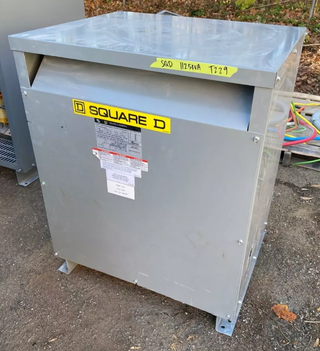Key Takeaways
-
Breakers trip as a safety feature to stop electrical hazards.
-
The top causes include overloaded circuits, short circuits, and ground faults.
-
Other culprits include faulty appliances, loose connections, or power surges.
-
In commercial and industrial facilities, panel capacity, large motor startup, and surge events need special attention.
-
Resetting a breaker repeatedly without diagnosing the issue can be dangerous.
Electricity keeps our offices and industrial facilities running, but when something goes wrong, safety systems step in. A tripped circuit breaker is one of the most common signs of trouble. While it can feel frustrating to lose power unexpectedly, that “click” you hear when a breaker flips is a protective measure. It prevents overheated wires, fire hazards, and costly equipment damage.
Understanding what causes a breaker to trip helps you troubleshoot issues more effectively, know when you can fix things yourself, and when to call a licensed electrician. For commercial and industrial operations, this knowledge is even more critical; downtime can result in lost productivity, halted assembly lines, or pose safety risks to staff.
How Circuit Breakers Work
A circuit breaker is like the traffic cop of your electrical system. It monitors current flow through wiring and instantly disconnects power if the system is under stress.
Most breakers use thermal-magnetic technology:
-
Thermal: Trips when wires get too hot from prolonged overload.
-
Magnetic: Trips instantly during a short circuit or ground fault.
Special breakers, like AFCIs (Arc-Fault Circuit Interrupters) and GFCIs (Ground-Fault Circuit Interrupters), offer targeted protection. AFCIs detect dangerous arcing inside walls, while GFCIs protect against shocks in wet or outdoor areas.
The Big Three Causes
Overloaded Circuits
Overloads happen when you draw more power than a circuit can safely carry. In commercial and industrial facilities, it could be running heavy machinery without dedicated circuits.
Signs of an overloaded circuit:
-
Breaker trips frequently during peak load.
-
Lights dim or flicker when machines start up.
-
Outlets or panels feel warm to the touch.
Fixes:
-
Spread out the equipment across multiple circuits.
-
Install dedicated lines for high-demand machinery.
-
Consider panel upgrades for growing facilities.
Short Circuits
A short circuit occurs when a hot wire touches another hot wire or a neutral wire, causing a sudden surge.
Symptoms:
-
The breaker trips instantly when equipment is switched on.
-
Sparks, burning smells, or visible charring.
Fixes:
-
Stop using the faulty device immediately.
-
Inspect wiring for melted insulation or exposed conductors.
-
Replace damaged outlets or cords.
Ground Faults
When electricity leaves its intended path and flows into the ground, breakers trip to prevent shocks.
Where they happen most:
-
Kitchens, bathrooms, or outdoor outlets exposed to water.
Industrial environments with damp floors or washdown equipment.
Fixes:
-
Use GFCI protection in required areas.
-
Repair moisture-damaged wiring and replace defective appliances.
Recommended Products in this Article
Other Common Triggers
Faulty Appliances or Outlets
Old or damaged equipment can leak current, causing breakers to trip repeatedly.
Loose or Corroded Connections
Terminals inside panels and outlets can loosen over time, creating resistance, heat, and sudden trips.
Aging or Worn Breakers
Like any mechanical device, breakers wear out. Nuisance tripping can be a sign it’s time for replacement.
Environmental Factors
Dust buildup, high ambient temperatures, or humidity can all affect breaker performance.
Industrial & Commercial Considerations
A breaker trip in a household may interrupt daily comfort, but in an industrial setting it can stop entire processes, damage equipment, and affect profitability.
-
Large motors and machinery: Inrush currents during startup may trip undersized breakers.
-
Panel capacity: Outdated panels can’t always support modern loads.
-
Selective coordination: In commercial settings, breakers must be sized so only the affected circuit trips, not the entire panel.
-
Surge events: Lightning strikes or grid fluctuations can trip breakers without proper surge protection in place.
Best Practices:
-
Conduct annual electrical load studies.
-
Install surge protection devices (SPDs) at service entrances.
-
Ensure labeling and documentation for quick troubleshooting.
Troubleshooting & Fixes
Step 1: Identify the Circuit: Check which breaker tripped and what it powers.
Step 2: Unplug and Test: Disconnect all devices, then reset the breaker. Plug items back in one at a time to find the culprit.
Step 3: Inspect for Damage: Look for burned-out outlets, frayed cords, or signs of water exposure.
Step 4: Reset Safely: Push the breaker firmly to the OFF position, then back to the ON position.
Step 5: Balance Loads: Move heavy-use items to other circuits.
Step 6: Call an Electrician: If trips persist or you see signs of damage, professional help is essential.
Prevention & Maintenance
-
Regular Inspections: Have panels checked annually, especially in high-load facilities.
-
Tighten Connections: Loose lugs cause heat buildup.
-
Upgrade Panels: If you’re constantly adding machinery, your panel may need expansion.
-
Install AFCI/GFCI Protection: Required by code in many situations.
-
Housekeeping: Keep panels dust-free and accessible.
Conclusion
A breaker that trips is doing its job, protecting your property and people from electrical hazards. By understanding the leading causes, recognizing warning signs, and knowing when to seek expert assistance, you can maintain a safe and reliable system.
At Brilliant, we supply the industrial-grade breakers, panels, and surge protection devices you need to power your facility with confidence.
Frequently Asked Questions About the Causes of a Breaker Tripping
What are the first three things to check when a breaker trips?
Check for overloaded outlets, unplug appliances, and inspect for visible damage.
How do I tell overload vs. short vs. ground fault?
Overloads build up gradually, shorts trip instantly, and ground faults often happen in damp conditions.
Can a single bad outlet trip the whole circuit?
Yes, if the outlet is shorted or leaking current, it can trip the breaker.
Is it safe to keep resetting a tripped breaker?
No. If a breaker keeps tripping, it’s a warning sign that requires investigation.
Do I need GFCI or AFCI breakers in commercial spaces?
Yes, building codes often require them in specific areas like kitchens, offices, and outdoor circuits.
When should I upgrade my electrical panel?
If your panel is older than 25 years, undersized, or constantly overloaded, it’s time to upgrade.
Can power surges or storms cause trips?
Yes. Surges from lightning or grid fluctuations can cause nuisance trips. Surge protection is recommended.




